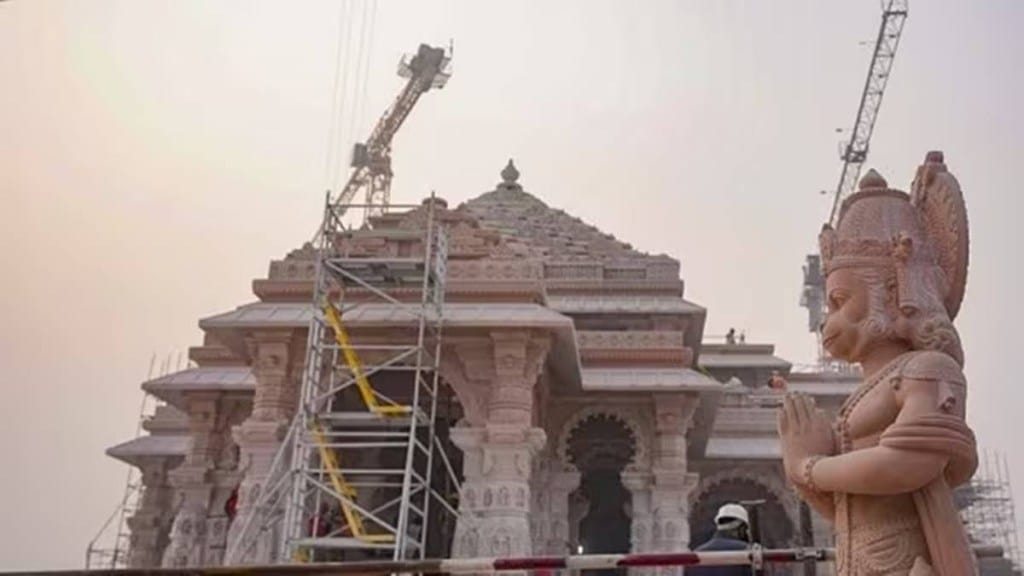The Pran Pratishtha ceremony of Ram Lalla at the Ram temple in Ayodhya marks a significant milestone in India’s cultural history and also draws the curtains on a long-drawn dispute that has sown sharp divisions in India’s post-Indipendent political landscape.
The inauguration of the Ram Temple, which will be thrown open to devotees from January 23, finds its roots in na struggle that is claimed to date back five centuries. While one side of the political divide believes that an ancient Ram Temple that stood at the site where the new Ram Temple stands today was demolished on the orders of Mughal emperor Babur and a mosque — that later came to be known as the Babri Masjid — was built in 1528-29 AD.
Also Read: Ayodhya Ram Mandir Inauguration Live Updates
A contrasting school of thought claims that the existence of the Ram Temple in Ayodhya in mere fiction and that the movement to build one in Ayodhya, believed to be the birth place of Lord Ram, was undertaken with an ulterior political motive. Regardless of which side of the divide you look at it from, the impact of the Ram Temple movement on India’s polity is significant and has left an indelible mark in India’s political journey.
The initial police complaint related to the Ayodhya dispute can be traced back to 1858, and the first cases were officially filed in 1885. However, the pivotal moment for the Ram Mandir movement only began in 1989 when the Vishva Hindu Parishad (VHP) conducted a ‘shilanyas’—the foundation stone-laying ceremony—at the contested Ram Janmabhoomi-Babri Masjid site. This was followed by the iconic Rath Yatra by BJP leader LK Advani, marking a pivotal milestone in the Ram Mandir movement that led to the demolition of the Bari Masjid by kar sevaks two years later on December 6, 1992.
Much of the narrative around the Ram Janambhoomi movement in India through the decades has been built through the strategic deployment of slogans. Throughout the campaign, a comprehensive structure of pan-Indian nationalism is meticulously erected, embedding unwavering faith in the hearts of the people through the powerful resonance of these carefully crafted slogans.
From mass mobilisation in the early 1980s and 90s to the era of embedding the element of nationalism to the movement post-2014, slogans have played a pivotal role in popularising and guiding the movement among the masses.
The eighties saw the advent of the Ram Temple movement through slogans like “Mandir Wahin Banayenge,” “Garv Se Kaho Ki Hum Hindu Hain,” “Jai Shri Ram,” and “Hindu-Hindu Bhai-Bhai Beech Mein Vardi Kaha Se Aayi”. These slogans not only helped popularise the movement, but also found resonance with a large section of the Indian population and shaped the narrative around the Ayodhya issue.
The slogan of “Mandir Wahin Banayenge”, utilised effectively by BJP leader Pramod Mahajan, has been central to the Ram Temple movement. So much so, that it led to a counter slogan by the Opposition which raised the slogan of “Mandir Wahin Banayenge, Tareekh Nahin Batayenge.” The Opposition’s slogan was a dig at the BJP which promised the constructiuon of the Ram Temple in every election manifesto but had failed to deliver on it due to lack of popular mandate and the ongoing legal dispute.
Another slogan that has etched its place in the national consciousness is of “Garv Se kaho Hum Hindu Hain”. The slogan, raised by Maharashtra heavyweight Balasaheb Thackeray, became inseparable with the Ayodhya movement and added an element of pride to the Ram Janmabhoomi movement. The slogans were amplified by his exceptional oratory skills during speeches that contributed significantly to the Ayodhya issue.
BJP leader Lal Krishna Advani’s Somnath-to-Ayodhya Rath Yatra will always remain critical to the Ram Janmabhoomi movement. The Yatra, besides sparking communal tensions in several states, weaved Hindutva into national consciousness and attached an element of urgency, even desperation, to the Ayodhya issue. Advani, through the Yatra, made a clarion call of “Ram Bhakti-Rashtra Shakti”, making Hindutva and nationalism inseparable from each other. “Badhe chalo, badhe chalo, mandir ki shaan ke liye badhe chalo, Hindutva ki shaan ke liye badhe chalo” was anothe rslogan popularised during the Rath Yatra.
The words of former Prime Minister Atal Bihari Vajpayee, an orator par excellence, were equally instrumental in shaping the Ram Janmabhoomi movement. Vajpayee’s assertion of “Kar sewa karenge aur hume koi rok nahi sakta (We will perform kar seva and nobody can stop us)” galvanised the masses, leading to the slogan of “Bari Bari Sabki Bari, Abki Bari Atal Bihari” in 1996. His verses: “Hindu tan man, Hindu Jivan – rag rag Hindu mera parichay” has been synonymous with the Ram Nadir movement through the decades.
The post-2014 era saw the emergence of Narendra Modi, a face that has remained a constant with the Ram Temple movement since the 1980s, and his ascent to the post of Prime Minister. Buoyed by the brute majority, the relgious slogan of “Jai Shri Ram” attained an element of “muscular nationalism”, something that fringe right-wing elements even used to launch targeted attacks on minorities. This went against PM Modi’s statement that “Ram is everywhere and Ram belongs to all”, embodying the essence of Bharat and what he claims is the beginning of cultural and national revival post-2014.

